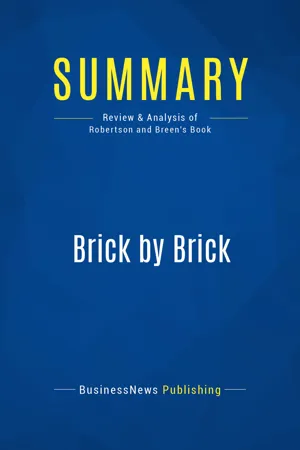
Summary: Brick by Brick
Review and Analysis of Robertson and Breen's Book
- English
- ePUB (mobile friendly)
- Available on iOS & Android
About this book
The must-read summary of David C. Robertson and Bill Breen's book: `Brick by Brick: How LEGO Rewrote the Rules of Innovation and Conquered the Global Toy Industry`.
This complete summary of the ideas from David C. Robertson and Bill Breen's book `Brick by Brick` explains innovation through the story of the LEGO Group. LEGO was founded in 1932 and through sheer grit and determination it grew into a multi-billion-dollar enterprise. However, at the end of the twentieth century, LEGO found itself fading as the digital world arrived. This summary highlights how LEGO's new management team developed a practical approach to innovation and as a result the company emerged from its near death experience to become one of the world’s fastest-growing and most profitable toy companies.
Added-value of this summary:
• Save time
• Understand key concepts
• Expand your business
To learn more, read `Brick by Brick` and discover the story behind the world's biggest toy company, LEGO.
Frequently asked questions
- Essential is ideal for learners and professionals who enjoy exploring a wide range of subjects. Access the Essential Library with 800,000+ trusted titles and best-sellers across business, personal growth, and the humanities. Includes unlimited reading time and Standard Read Aloud voice.
- Complete: Perfect for advanced learners and researchers needing full, unrestricted access. Unlock 1.4M+ books across hundreds of subjects, including academic and specialized titles. The Complete Plan also includes advanced features like Premium Read Aloud and Research Assistant.
Please note we cannot support devices running on iOS 13 and Android 7 or earlier. Learn more about using the app.
Information
Summary of Brick By Brick (David C. Robertson with Bill Breen)
1. The Seven Truths of Innovation and LEGO’s Decline
- Values are priceless – and should act as guiding principles for the enterprise at all times and in all settings.
- Relentless and persistent experimentation bears dividends – it will always get you to the future first. LEGO often places multiple bets on new innovations and then hangs tough long enough to reap the rewards. The fact LEGO took a decade to perfect its brick was no real surprise.
- LEGO is good at seeing the big picture – it realized early that it had to evolve from producing stand-alone toys to creating an entire system for kids to play with using the brick as the central element.
- LEGO focuses tightly – as exemplified by the fact the company dropped manufacturing wooden toys which accounted for 90 percent of its revenue in the mid-1950s in order to concentrate on plastic bricks. This was a bet-the-company proposition at first but eventually the advantages of building a plastic toy which is infinitely expandable came to the fore.
- LEGO works to make everything authentic – it created a kid’s fantasy world that grew out of their real lives and involved toys which were miniature versions of familiar things. It was not unusual, for example, for children to get LEGO tractors at the same time as their father’s bought new tractors for their farms.
- The LEGO Group works hard at getting retailers onboard first and building strong personal ties with them – so they became enthusiastic promoters of the LEGO range. While the company’s products are sold to children worldwide, the retailer’s interests have always been accommodated and prioritized by LEGO.
Table of contents
- Title page
- Book Presentation
- Summary of Brick By Brick (David C. Robertson with Bill Breen)
- About the Summary Publisher
- Copyright